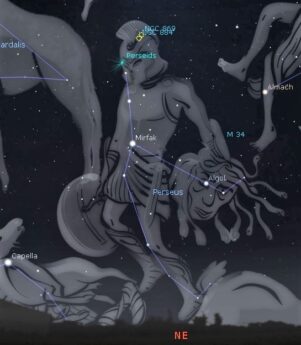This Week’s Sky at a Glance, 2023 August 12 – August 19
This Week’s Sky at a Glance, 2023 August 12 – August 19
With the Perseid meteor shower peaking this weekend, let us visit its namesake constellation. Perseus the Hero stands on the northeastern horizon by midnight, just below the W shape of his mother-in-law, Cassiopeia. He is a hero because, among other deeds, he prevented his future wife Andromeda from becoming a tasty lunch for a ferocious sea monster.
The brightest star in Perseus, Mirfak, is part and namesake of the Alpha Persei Cluster. This is one of my favourite binocular targets because it resembles a miniature version of the constellation Draco. Another popular binocular target is a close pair of star clusters – NGC 869 and NGC 884 – located halfway between Perseus and Cassiopeia, which astronomers have cleverly called the Double Cluster. The Perseid meteors appear to originate from a point near the Double Cluster.
The constellation’s second brightest star is Algol the Demon, representing the eye of the Gorgon Medusa. Perseus beheaded the Medusa in a plan to avenge an embarrassing moment by using her head to turn his hecklers into stone. The sea monster was his first victim with this weapon. Algol is famous for dimming by a factor of three every 69 hours. It is a very close pair of stars orbiting each other in our line of sight, and their combined brightness drops when the dimmer star passes in front of the brighter one. Look for the star cluster M34 about a binocular width above Algol.
This Week in the Solar System
Saturday’s sunrise is at 6:21 am and sunset will occur at 8:36 pm, giving 14 hours, 15 minutes of daylight. Next Saturday the Sun will rise at 6:29 am and set at 8:24 pm, giving 13 hours, 54 minutes of daylight.
The Moon is new on Wednesday, and the slim crescent passes just to the upper right of Mars on Friday. Venus is at inferior conjunction this weekend and Mercury is too close to the Sun for viewing. By midweek Saturn rises around 9 pm followed by Jupiter two and a half hours later. The Perseid meteor shower peaks early Sunday morning but the show is often worth sacrificing some sleep time a night or two before and after.
There will be public observing at the Irving Nature Park in Saint John on August 11 at 9 pm, with a back-up date of August 12.

